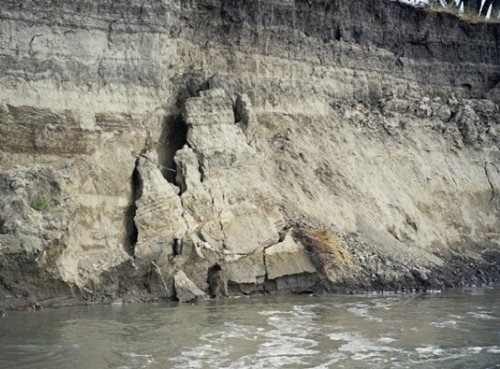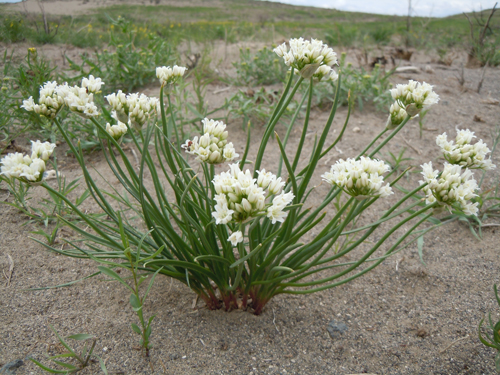Early in the day, a crumbling bank threatens the red pirogue. Spending the rest of the day exploring the mouth of the Little Missouri River, the expedition members see beaver, empty Assiniboine camps, creeping juniper, and wild onions.
Passing Under a Falling Bank
by Yellowstone Public Radio[1]Originally aired weekdays by Yellowstone Public Radio during the Bicentennial observance of 2003-2006. Narrated by Hal Hansen. Scripts by Whit Hansen and Ed Jacobson. Produced by Leni Holliman. © … Continue reading
Passing Danger
the red perogue contrary to my expectation or wish passed under this bank by means of her toe line where I expected to have seen her carried under every instant . . . . much to my satisfaction arrived safe above it. this cost me some moments of uneasiness, her cargo was of much importance to us in our present advanced situation—
—Meriwether Lewis
Ellicott’s Artificial Horizon
The artifil. Horizon recommended by Mr. A. Ellicott, in which water forms the reflecting surface, is used in all observations which requirs the uce of an Artificial horizon, except when expressly mentioned to the contrary.—
—Meriwether Lewis
Little Missouri River
The little Missouri disembogues on the S. side of the Missouri 1693 miles from the confluence of the latter with the Mississippi. it is 134 yards wide at it’s mouth, and sets in with a bould current but it’s greatest debth is not more than 2½ feet. it’s navigation is extreemly difficult, owing to it’s rapidity, shoals and sand bars. it may however be navigated with small canoes
—Meriwether Lewis
Empty Assiniboine Camps
remains of Minetarra [Hidatsa] & Ossinneboin [Assiniboine] hunting Camps are to be Seen on each Side of the two Missouris
—William Clark
Wild Onions
found a great quantity of small onions in the plain where we encamped; had some of them collected and cooked, found them agreeable. the bulb grows single, is of an oval form, white, and about the size of a small bullet; the leaf resem that of the shive
—Meriwether Lewis
Creeping Juniper
on the side of a hill not distant from our camp I found some of the dwarf cedar of which I preserved a specimen (See No. 2). they grow so close as perfectly to conceal the eath. I have often thought that this plant would make very handsome edgings to the borders and walks of a garden;
—Meriwether Lewis[2]This specimen was destroyed along with several others in a cache above the Great Falls. An earlier specimen was sent from Fort Mandan in the barge (called the ‘boat’ or … Continue reading
Weather Diary
State of Thermometer at rise
Weather Wind at rise
State of Thermometer at 4 P.M. Weather Wind at 4 P.M. State of the River 56 [above 0] fair N. W. 74 [above 0] cloudy after rain, thunder, and lightning W. raised 1/8 in. small shower from the W. attended with hard wind.
—William Clark and Meriwether Lewis[3]To assist the reader, the editor of this web page has omitted the date column, clarified the “State of the River” information, and spelled out some abbreviations.
Experience the Lewis and Clark Trail
The Lewis and Clark Trail Experience—our sister site at lewisandclark.travel—connects the world to people and places on the Lewis and Clark Trail.
Plan a trip related to April 12, 1805:

Notes
| ↑1 | Originally aired weekdays by Yellowstone Public Radio during the Bicentennial observance of 2003-2006. Narrated by Hal Hansen. Scripts by Whit Hansen and Ed Jacobson. Produced by Leni Holliman. © 2003 by Yellowstone Public Radio. |
|---|---|
| ↑2 | This specimen was destroyed along with several others in a cache above the Great Falls. An earlier specimen was sent from Fort Mandan in the barge (called the ‘boat’ or ‘barge’ but never the ‘keelboat’). See Moulton, ed. Herbarium, specimen 84. |
| ↑3 | To assist the reader, the editor of this web page has omitted the date column, clarified the “State of the River” information, and spelled out some abbreviations. |


